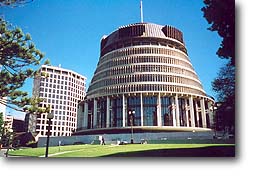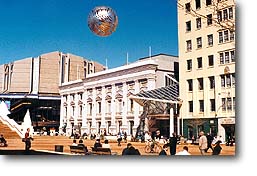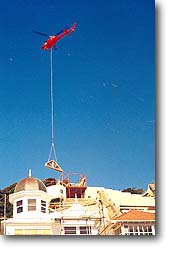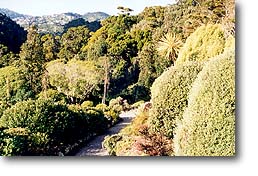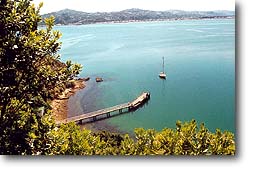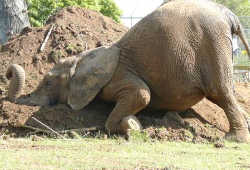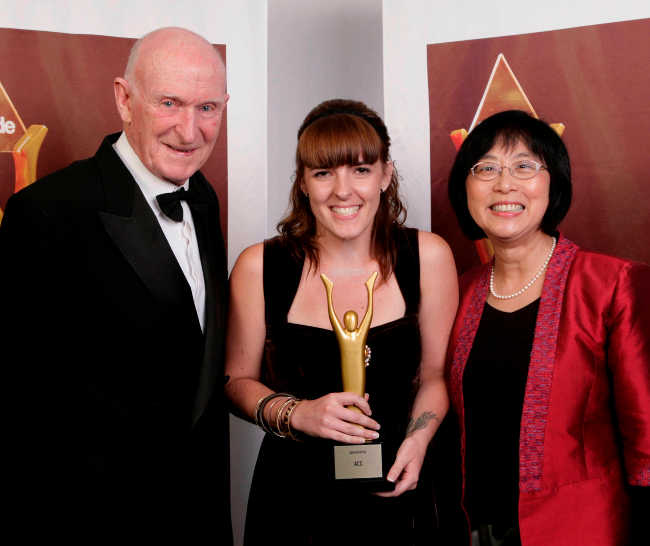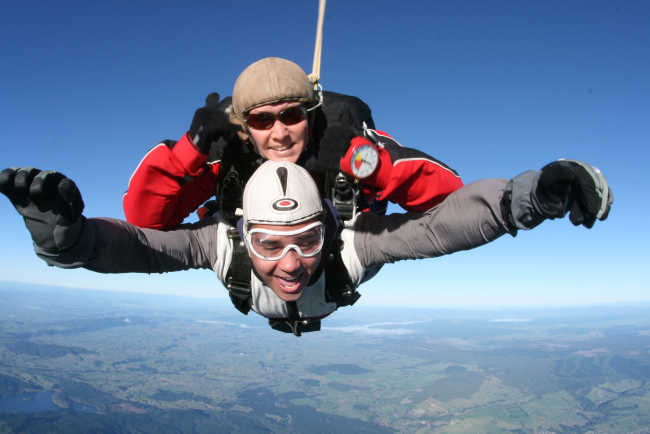A vibrant and beautiful city
Dorothy – 24/05/02
How to get there Wellington has a busy national and international airport close to the city. You can also arrive by a choice of train, bus or ferry travel.
Where to stay Wellington offers a wide range of accommodation with something to suit all travellers’ budgets. Hostels offer a good way of meeting other travellers and homestays (usually offering bed and breakfast) give you a chance to meet Wellingtonians in their own homes. There is a wide range of self contained motels where you have a fully equipped kitchen to cook your own meals, and hotels for those who think it is important on a holiday to be waited on.
Wellington is a popular place so it’s wise to book accommodation ahead.
Where to eat You don’t need accommodation where meals are provided as Wellington offers an amazing choice of places to eat – 400 cafes and restaurants, which according to Totally Wellington Tourism, is more per head of population than New York!
What to do When you visit Wellington the question at the beginning of the day is not “What shall I do today?” but “Which of the interesting activities shall I choose?”
Getting an overview It is easy to get an overview of this city built around the harbour and encircled by hills. You can get to a good viewing point by riding up the hill in the cable car from Lambton Quay or by driving or taking a tour to the top of Mt Victoria.
The Wellington Cable Car The cable car starts at 280 Lambton Quay (next to McDonald’s) and runs past Victoria University and Kelburn Part to the top of the Botanic Gardens. It was opened in 1902 which means that this is its centennial year. It was redesigned in 1978 and continues to give passengers easy access to Kelburn. From the top of the cable car route you will be able to see up the harbour to the Hutt Valley and across to Mount Victoria.
Why not visit the coffee and snack bar at the top or have a meal in the restaurant while enjoying the view? To add interest to the trip take the cable car up the hill and walk down through the Botanic Gardens.
Mt Victoria
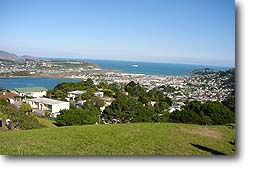 |
| View from Mt Victoria showing the airport and a ferry on the water. Click here for a larger version |
From the viewing points on the top there are views in all directions.
There is a lookout which has the following inscription:
This lookout was erected as a Centennial Memorial September 1939. It commemorates the founding of the City by Settlers organised by the New Zealand Company. The first actors in the Drama arrived in Wellington Harbour in the “Tory” from England on September 20, 1839. The City took the name of Wellington from the Great Duke who assisted the passage of Wakefield’s Australian Colony legislation through the English Parliament. The granite wall of the lookout is the gift of the London County Council and formed part of the Waterloo Bridge, London, which was opened by the Duke of Wellington in 1817 and demolished in 1938.
In the lookout there are bronze busts of the Duke of Wellington and Edward Gibbon Wakefield.
Go walking with so much close at hand You don’t need to have a car to enjoy Wellington. It is possible to walk the length of the central city in twenty minutes, but you won’t want to rush as there is so much to see as you walk. Why not join a guided walking tour as a first exploration and then go back to spend longer in the places of your choice? Tours leave outside Starbucks Coffee on Lambton Quay. They are run every day in the summer, and at weekends in the winter. Find out the times for City tours or Waterfront tours. Starbucks is in the Old Bank Arcade and Chambers – beautifully restored old buildings with upmarket shops.
Phone 04 384 9590 or 04 477 4112 Email: walkwellington@xtra.co.nz
Bus tours An alternative plan for getting to know the city is to use the City Circular – a bus service which takes you to the most interesting inner-city locations. Or you can study the timetables and maps and ride the city’s electrically-powered trolley buses.
Land reclamation The names Lambton Quay and Thorndon Quay are not dreamt up by someone’s vivid imagination. Originally they were quays with small jetties built out to serve shipping. The inner city from these quays to the present shoreline stands on land reclaimed from the harbour. The development of the area adds extra interest to the guided Waterfront walking tour.
Historic buildings Wellington has been New Zealand’s capital city and seat of Government since 1865 when difficulties with communication resulted in the capital being shifted there from Auckland in the north. After much dissension and debate Parliament voted for the move to Wellington as a city near the centre of the country. This means that there are a number of buildings significant in New Zealand’s history.
Parliament Buildings A good starting point would be Parliament Buildings. It is possible to take a tour of the fine buildings. In the basement you will be shown the base isolators – a sandwich of rubber and steel in a block inserted between the base of the buildings and the foundations, to allow for some sideways motion in an earthquake. The concept of base isolation was invented by a Lower Hutt man to protect large buildings in earthquakes, and it is widely used to strengthen new buildings, but Parliament Buildings are one of the largest building complexes where base isolation has been installed in an existing structure.
Marble used in this building came from the Takaka Hill.
General Assembly Library
|
|
| General Assembly Library Photo source Alister Hunt |
|
|
| The Beehive Photo source Alister Hunt |
Adjacent is the Gothic building of the General Assembly Library opened in 1897. It is the home of research facilities for Members of Parliament, but also holds considerable newspaper files and it is a legal requirement that copies of all New Zealand publications be held there.
The Beehive – a landmark There was to have been a further wing on the left, but instead the new extension took the form of the Beehive, the executive wing which houses the offices of Ministers, the Prime Minister’s Department and the Cabinet Room and the headquarters of the National Civil Defence system. A well-known story about the design of the building is that it was sketched on a cigarette packet as a joke by a designer who never imagined that it would be built.
Nearby is the old Government Building said to be the second largest wooden building in the world. It was built on a small area of reclaimed land and when it was opened in 1876 it was the largest building in the country. Extensive restoration was undertaken from 1994 to 1996 and it now houses the University Law Faculty. Visitors can take a self-guided tour of the beautifully restored building.
Te Papa Te Papa has been described as “more than a museum”. It introduces visitors to New Zealand’s wildlife, history, Maori culture, and contemporary art and culture. The four Discovery Centres have special interactive fun for children. Time Warp lets you experience New Zealand’s past, including its formation, and possible aspects of its future. Admission is free except for Time Warp and some short term exhibitions.
Tours of Te Papa include a trip to the basement to see the base isolators described above. Te Papa has 3 coffee bars/restaurants with the Icon Restaurant being a well known top of the range eating place.
A range of other contrasted activities in the city You can visit the Museum of Wellington City and Sea housed in a historic building, Katherine Mansfield’s birthplace which has been authentically restored, Old St Paul’s and Wellington Cathedral of St Paul, numerous galleries displaying New Zealand arts and crafts, or shops selling clothes designed by New Zealanders.
Happenings I’ve mentioned a lot of permanent attractions, but look at Wellington’s calendar of events and you’ll find that there is always something new happening, summer and winter. In December 2001 the Australasian premiere of the first movie in the Lord of the Rings series, The Fellowship of the Ring, screened in Wellington where many scenes were filmed and all of the post-production work was done. In February/March there was the New Zealand Festival of the Arts which happens every two years in Wellington and attracts many visitors, local and international.
|
|
| Silver Ball in the sky in the Civic Square |
In the Michael Fowler Centre throughout the year there are performances by the New Zealand Symphony Orchestra, the Royal New Zealand Ballet, the National Opera and visiting musicians. You’ll have no trouble finding the Michael Fowler Centre. Look upwards in the sky above the Civic Square for the silver ball, beautifully crafted by New Zealand sculptor, Neil Dawson.
There are three professional theatre companies, and numerous art and craft exhibitions. Major sporting fixtures are held at the new WestpacTrust Stadium and other venues. The list goes on and on….
Suburbs and houses on the hills
|
|
| Building material delivered by helicopter |
Take a car or bus trip through the suburbs of Wellington and you will marvel at the array of different architectural styles -from nineteenth century cottages of the pioneers, two storey houses of the affluent in the Victorian and Edwardian eras, state housing from the 1930s and 1940s, through to avant garde architecture devised for very small pieces of land, often with very difficult access. I sat watching in amazement a house being built above Oriental Bay, with a helicopter delivering building material for which there was no other possible access. As you drive notice the houses serviced by private cable cars!
Back to Nature Long established areas For nearly a century the Otari-Wilton’s Bush Native Botanic Garden dedicated solely to the preservation and interpretation of New Zealand’s native plant life, has drawn visitors to its walks and trails to learn about native plants and see native birds. The Wilton bus takes you to the gate.
You can also go by bus directly to the Wellington Zoo which has special programmes to support endangered species – both New Zealand natives like the brown kiwi, the New Zealand giant weta and the black stilt (kereru), and from other countries the red pandas from Nepal, the Malayan Sun Bears, and the Sitatunga Antelope.
|
|
| Native trees in Otari-Wilton’s Bush Native Botanic Garden |
Gone is the old format of bare
cages. For instance you can follow a Tropical River Trail through rain forest filled with animals and birds.
Wellington’s newest Back to Nature venture – the Karori Sanctuary Ten minutes from the city centre 252 hectares of regenerating forest have been established as a pest-free sanctuary and native species have been re-introduced. A state of the art predator-free fence surrounds the area. Visitors are welcome to walk in the sanctuary and enjoy the bush and the bird calls in the weekends and on public holidays (except Christmas Day). Opening hours are 10 am to 5 pm.
Island reserves Somes Island, once the quarantine station, is open to visitors who can go there by ferry.
|
|
| Somes Island Photo source Alister Hunt |
Another beautiful island, Kapiti Island, 45 minutes north of Wellington, is New Zealand’s oldest nature reserve, where visitors are allowed to visit any day of the week provided they have a permit. Walking here in the bush is like stepping back in time and seeing New Zealand’s wildlife as it once was
Kapiti Marine Charter runs a daily ferry service to the island. Visitor’s permits can be obtained from the Department of Conservation Phone: 04 472 7356 Ferry bookings, phone 04 297 2585, 08004 FERRY or 025 424 850.
Native birds from Kapiti Island have been taken to increase the bird numbers in the Karori Sanctuary.
Parks and picnics
Close to the suburban railway or the bus is Khandallah Park from which you can walk up Mt Kaukau (445 metres above sea level) through native bush, see native birds, and from the top enjoy spectacular views.
If you are prepared to travel further – into the hills beyond Upper Hutt – you can visit Kaitoke Regional Park and walk in the bush, or swim in the pools in the river. Tracks are marked and range in length and difficulty from easy walks taking up to an hour, to The Ridge Track – a six hour round trip.
Contact the ranger if you want to join a commercial rafting trip on the Hutt River.
Battle Hill Farm Forest Park near Paekakariki, Belmont Regional Park on the road between Porirua and Lower Hutt, Wainuiomata Waterworks, and a number of parks in the hills around Upper Hutt all offer outdoor activities and picnic areas.
For more information contact the Wellington Regional Council or pick up their excellent pamphlet about Wellington Regional Parks.
Wellington named as Top Town North and South magazine named Wellington as Top Town. Plan to visit Wellington and find out for yourself why this beautiful and vibrant city was nominated for this honour.


